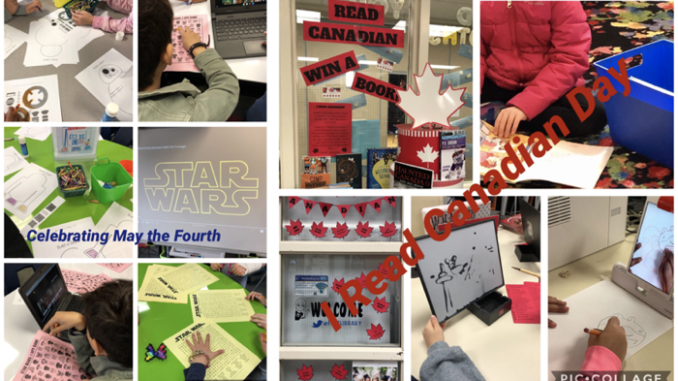
Seeing passive programming as active, self-directed learning
By Heather Stoness
A couple of years ago our board decided to reduce our teacher-librarian (TL) allocation, which meant we were still trying to service the same number of students we previously had on top of an additional teaching assignment. Passive programming became my solution to remaining actively engaged with my students and staff in my school. Passive programming is when activities are set up without the need to have direct teacher support. We often hear the word passive and think submissive, complaisant, compliant but passive programming is none of this. Passive programming is active, self-directed learning. There is nothing passive about this style of programming!
Passive programming offers an opportunity to engage with students when you cannot be in the space (for example a part-time teacher-librarian allocation) or when you are otherwise engaged with another class or group of students. In the past, when I was a full time TL I would have multiple classes in my Library Learning Commons (LLC) at a time. Quite often I would be delivering a lesson to one class, while a homeroom teacher was doing book exchange with their class. I used passive programming as a way to keep the class doing book exchange engaged throughout their time in the space. It provided an activity for students who could not choose a new book to participate in and keep them busy, as well as something for students to take part in once they had finished selecting their books.
Since our board has reduced TL allocations I now use passive programming to keep connected to my students even though I may not see them personally as often as I would like. It is a great way to highlight resources that I don’t have time to promote one-on-one. I have found that these activities help build community within our school. It is also a great way for students to see the connection between school and board initiatives within the LLC.
Benefits
There are many benefits to incorporating passive programming into your LLC. One benefit is the flexibility within a program’s length. You can choose how long to offer your passive program. You can run a specific program for a month or even for just a day or a week. Passive programming can be easily tied into school initiatives, curricular contexts and/or special calendar events. It helps students to see how the LLC is an extension of the classroom and builds community within the school.
Passive programming allows the TL to engage the attention of students through affirming students’ social identities and cultural representation using pop culture and current trends, and secretly occupy them in library activities without them seeing them as onerous tasks or even library related. You can scaffold different passive programs to give every student an entry point. Popular passive programs can be reused year after year. Students enjoy seeing their favourite passive programs come back into the LLC. Passive programming is also completely customizable to your space, your school population and community. The largest benefit to passive programming is the opportunity for the program to run without the direct involvement of the teacher-librarian.
Challenges
Although passive programming has many benefits it does come with its challenges. Probably the biggest challenge is the initial time you need to invest into getting the programs ready. Depending on the complexity of the program that you are trying to set up it could take quite a bit of time to get the program organized. Creating individual kits can be time consuming, whereas if you are looking at just offering printables, like colouring sheets, word searches or crossword puzzles it won’t take as long.
When planning your programs you do need to consider the support that is required for a particular activity and determine if the program can run without adult direction if you are not in the space. If it can’t run without some support it would not be an activity that you would set up when you are not in the space. You may also need to think about creating an orientation for passive programming so that students understand the expectations around the activities. Think about including this as part of your September orientation so that students have the opportunity to try passive programming when the TL is in the space and have the TL’s support. It also helps to reinforce the expectations, particularly those around noise level. Students often get excited with the passive programming activities and sometimes their enthusiasm is shown with an increase in volume. This is particularly important especially if your space is used by multiple classes or groups at a time.
If you are short on space in your LLC it can sometimes be challenging to find activities that will work for all age levels in your school. Offering modifications and/or extensions allows the programs to be open and accessed by all grade levels. Since passive programming does not require direct supervision or involvement you may find that items get lost or damaged. Anticipate this and always make sure you have extras set aside so that you don’t have to use more time prepping to replace lost or damaged items.
The other challenge is not every activity will be a success. This can sometimes be difficult to accept, especially if a lot of time went into prepping the activity, but with everything there are some wins and some losses. I can guarantee that most of the programs you put into place will be wins because students like the opportunity to participate and be engaged.
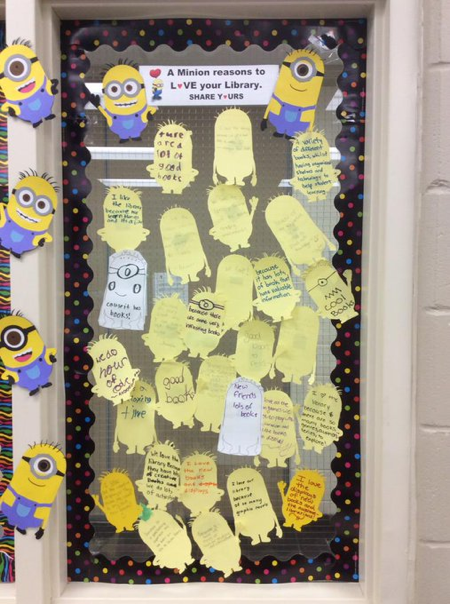
LLC. Students and staff share what they
love about the library learning commons.
Five Types of Passive Programming
I divide up my passive programs into five types: Interactive displays, Provocations, Scavenger Hunts, Grab and Go Bags, and Stations.
Interactive Displays
Interactive displays allow students to participate or engage in material that is posted. I have several different types of interactive displays that I include as part of my passive programming. The first are feedback displays. These are displays where students participate by responding to a particular prompt or question. The goal of these displays can be to gather feedback or data on a topic. For example, having students share what they love about the LLC (see Figure A).
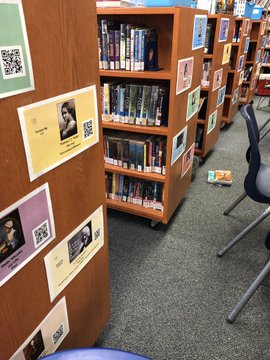
Students scan the QR code to learn more
about important Black people in history.
Another type of interactive displays that I create as part of my passive programming are those where the student actively interacts with the display through the use of technology to learn more information on a specific topic. For example, having students scan QR codes to pull up an article on a particular person of importance (see Figure B). These displays can be tied back to a trivia contest to help motivate students to read or listen to the information being presented.
The third type of interactive display that I use in my programming are polls. These automatically incite student engagement because students get to use stickers or bingo daubers to vote on a prompt. These displays are easy to tie in with pop culture and current literary events. Students like to engage in conversations around these displays because they can visually see the responses. Examples include a favourite book to movie film adaption, having students respond to their favourite dystopian fiction, or “would you rather” questions (see Figure C).
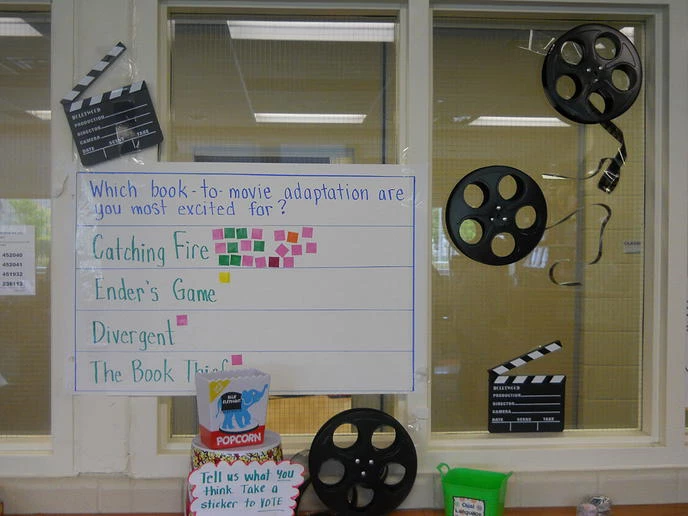
favourite book to movie adaptation.
The last type of interactive display that I like to create are those that take a deconstructive approach to the breakout box. A breakout box is an activity where students are trying to break into a box that is locked with several different kinds of locks. Through solving puzzles, riddles and clues students figure out the different lock combinations to open up the locks and break into the box. Breakout boxes promote the global competencies, collaboration, and critical thinking. They provide a great opportunity for students to build their inference skills. Instead of having all my locks on one box I deconstruct the box so that students follow a sequence of individual boxes, solving the clues to open one box after another (see Figure D).

solving riddles and puzzles to breakout to find the ninth horcrux.
Feedback displays are a great way to gather student voices in your space and actively engage in the information being presented.
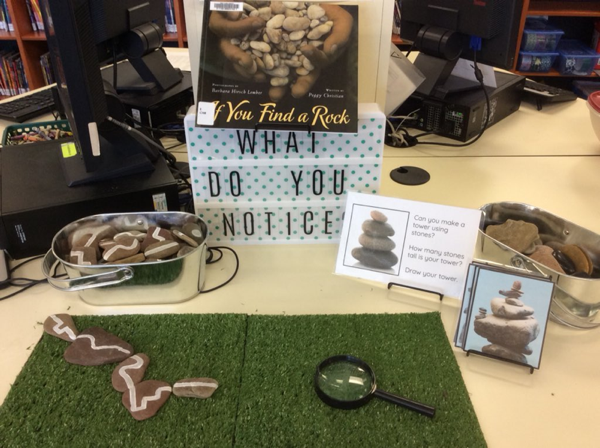
This is a popular provocation enjoyed by all grades.
Provocations
Provocations are deliberate and thoughtful decisions made by the teacher-librarian to extend the ideas of the students. They are intended to provoke thoughts, ideas, and actions that help to expand on a thought, project, idea, or an interest. The teacher-librarian provides materials, media and general direction as needed, but the students take the ideas where they want.
I like to have one table in my space dedicated to provocations. I switch out the provocations each month. I have found that regardless of how primary the provocation may look, all students including the Grade 8s like to engage in the materials (see Figure E).

you can see an example of a tinker tray.
My provocations can include the use of tinker trays. A tinker tray is just an organization of loose parts in a type of tray. I like to use the chip and dip trays from the dollar store (see Figure F). The trays offer students the opportunity to explore materials and come up with new and exciting ways to use the materials. They promote creativity and decision making. To help keep the trays organized I take a photo of the material that belongs in each section of the tray and tape it to the bottom. This gives students a visual of where the materials go when it is time to tidy up. The use of loose parts and tinker trays are easy and quick provocations to set up because you are just putting out the materials and the students come up with how they will use them.
Provocations can easily be tied into new books in the LLC, highlight current curricular topics happening in the classroom or engage students to inquire and innovate.
Scavenger Hunts
Scavenger hunts are another easy passive program to set up. It simply involves hiding things in your space for the students to find. With the reduction in my TL allocation I don’t have the luxury of spending as much time as I used to on library orientation in September (Figure G). This passive activity is a great way to review the different locations of all of our collections, as well as the different zones in our LLC. Throughout the year I will set up a scavenger hunt that ties back to pop culture or literature to engage students in the space but secretly it is another way to reinforce the different spaces in the LLC.
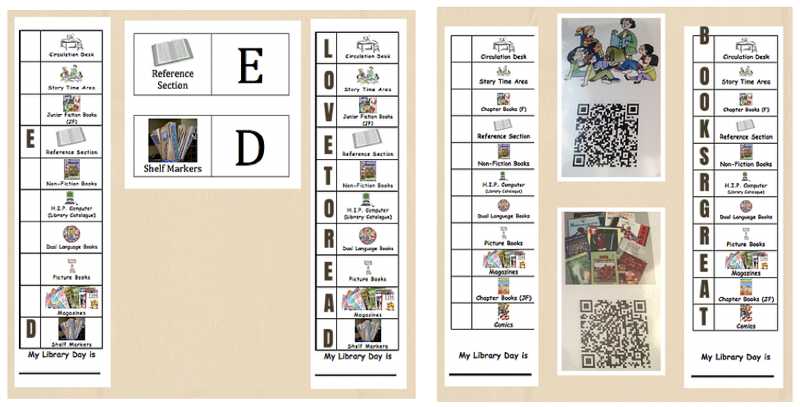
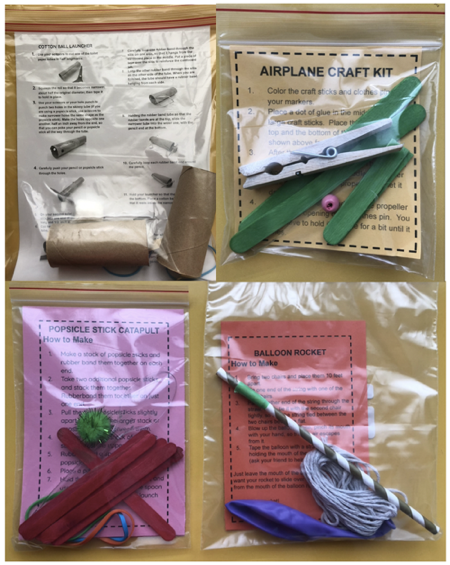
and science kits.
Grab and Go Kits
Grab and go kits are one of the most popular passive programs that I offer. I create three different grab and go kits: craft kits, science kits and maker kits. Students are able to engage with these kits in the LLC or are welcome to take them home. Those that choose to take them home are encouraged to either bring back and show what they made or take a photo to share on our gallery wall in the LLC. The premise is the same for all the kits: they are to encourage creativity, innovation, and self-discovery. Each kit includes materials, instructions, and reflection/discussion questions (See Figure H).
Stations
Stations are an easy way for me to create a passive program that lasts for a longer duration, usually a month. The stations are set up in the LLC to compliment current library programming (Figure J) and highlight special calendar events (Figure K). Since all of our book exchange is done by homeroom teachers to maximize the opportunity for co-planning and co-teaching with the TL, stations can be used to offer programming to classes that are in the LLC when I am not available. There are usually four to five stations available, which allow all students to explore a different station each time they come down to the space in a month. The stations are consistent in their formatting to help students anticipate what they need to do at each station without extensive teacher support. For example, there is always a colouring station, always a research station, always a create station, etc.. Stations have made it easy for me to provide library programming with direct instruction and still keep the students excited to come down to the LLC.
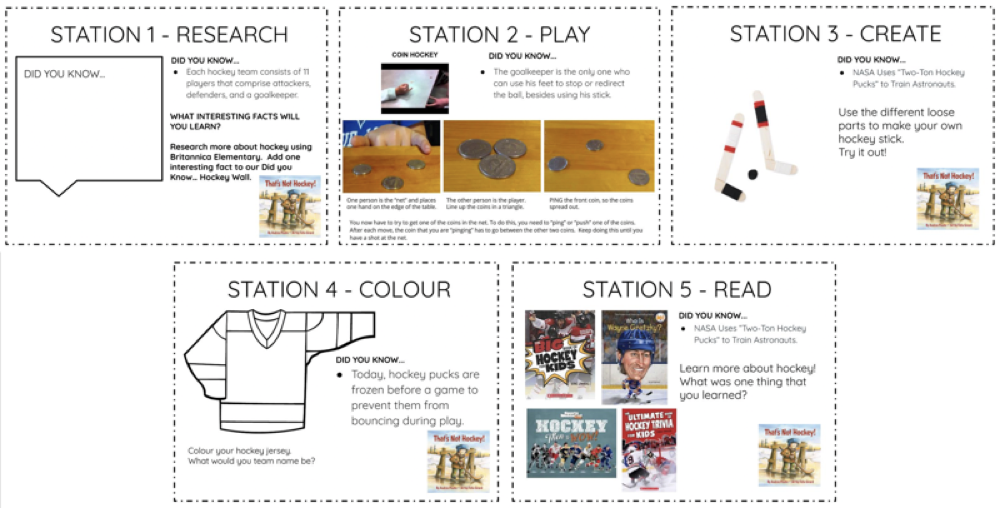

Evaluating Success
You will want to consider how you will be evaluating the success of your different passive programs. Gathering feedback will allow you to see which programs to reuse, which programs you need to tweak, and which programs you might scrap.
Think about creating an exit pass which students complete after they do a particular activity. The exit pass does not need to be onerous. It could be a visual exit pass for primary students where they simply complete the face with how they enjoyed the activity. With older students you could have them give you one word to describe their experience today, or you could ask more detailed questions regarding the specific activity and have them provide feedback on what they enjoyed and what they would change.
If your program includes tangibles that the students take with them or use within the program you can track the quantity of materials being consumed or the number of kits that are being used. A punch card is another way to track student participation and this can be tied into incentives being offered. A student would get their card stamped or punched each time they participate.
The last way is to have students sign up for specific activities and keep the attendance sheets to evaluate the popularity of the program. Gathering feedback is important because it gives evidence of the program’s success, demonstrating how the activities in the LLC impact student well-being, and supporting future budget requests to your principal.
The Heart and the Hub of the School
There are many different ways that passive programming can look like in the library learning commons. Regardless of how you choose to implement this type of programming you will find that the benefits far outweigh the challenges. Passive programming is a way for students and staff to keep connected to the LLC. It is this connection that keeps the LLC at the heart and hub of any school.

Heather Stoness is currently a teacher-librarian and planning teacher in the Halton District School Board. Passionate about teaching, learning, and application of new technology in the learning commons environment, Heather is invested in empowering students to become successful lifelong learners. She was also the 2019 recipient of the OSLA Teacher-Librarian of the Year Award.